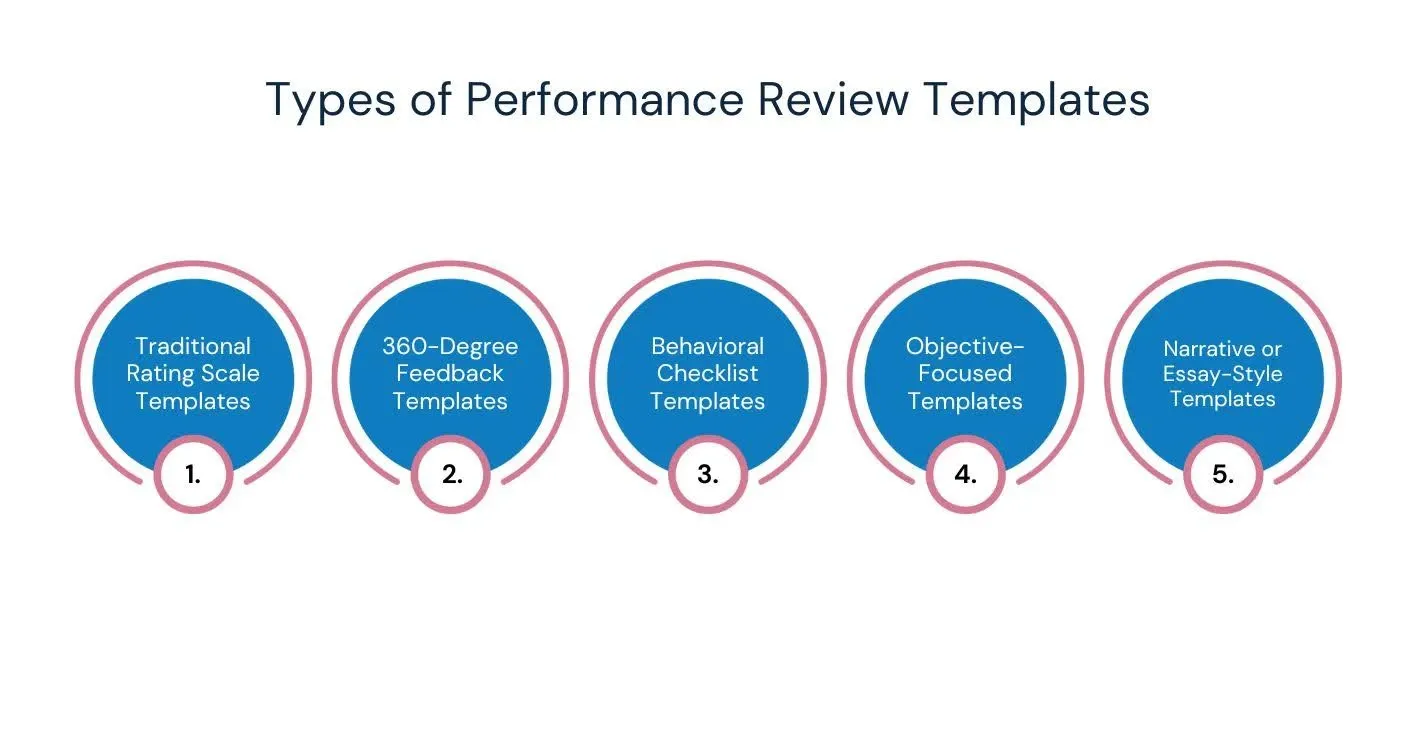
Performance appraisals often become daunting and inconsistent without the right tools. Many organizations struggle with subjective reviews, which can lead to confusion and disengagement among employees.
Well-designed staff performance appraisal templates address this issue by providing a clear, structured framework that ensures fair and comprehensive evaluations. These templates help cover essential areas, making feedback meaningful and aligned with organizational goals.
In this guide, we will explore the key components of effective appraisal forms, different template types, best design practices, and how to customize them to suit various roles.
An appraisal form is a structured document used to evaluate an employee's performance, achievements, and areas for improvement over a defined period. It serves as a formal tool for managers to provide feedback, assess goal attainment, and identify areas for personal and professional development.
The form typically includes various sections, such as competency evaluations, target achievement, and behavioral assessments, with both quantitative and qualitative data. A well-designed staff performance appraisal template helps managers evaluate employee contributions consistently and fairly.
Appraisal forms allow employees to reflect on their own performance, set personal goals, and engage in a constructive conversation with their managers. Additionally, they help ensure that assessments align with organizational objectives and employee development plans.
Suggested Read: Understanding What 75th Percentile Means in Salary Compensation
Creating an effective performance appraisal form requires careful planning and consideration of both organizational needs and employee development. The goal is to design a form that captures relevant performance data, provides valuable feedback, and encourages employee growth.
Using a staff performance appraisal template simplifies the review process and ensures all key performance areas are covered.
Below is a step-by-step guide to creating a comprehensive and effective appraisal form.
Before creating the form, it's essential to clarify the purpose of the appraisal. Is it to evaluate overall performance, assess skills, or identify areas for improvement? Clear objectives will guide the structure of the form and ensure it meets the needs of both managers and employees.
At the beginning of the form, include space for basic employee details. This ensures that each appraisal is properly identified and linked to the individual.
Performance criteria should align with job responsibilities and organizational goals. Define key competencies that are relevant to the employee's role. These can be categorized into skills, behaviors, or results.
A rating scale helps quantify performance and provides a simple way for managers to communicate how well employees meet expectations. Common scales include:
Set aside space for discussing past goals and achievements. This section encourages employees to reflect on their accomplishments and provides managers with a clear picture of performance relative to objectives.
In addition to technical performance, assessing an employee's behavior and attitude is crucial for a holistic review. This includes their interpersonal skills, work ethic, and alignment with company culture.
Suggested Read: Steps to Create a Fair and Equitable Compensation System
Provide space for detailed, constructive feedback. Customizing a staff performance appraisal template to fit specific roles enhances the accuracy and relevance of evaluations. This section should focus on both strengths and areas for improvement.
Allow employees to reflect on their own performance. This helps them feel engaged in the process and encourages open communication.
At the end of the appraisal form, summarize the overall performance, providing a final rating or evaluation. Both the employee and supervisor should sign the form to acknowledge that the evaluation has been discussed and understood.
The next section highlights the different types of performance review templates you can use to optimize evaluations and ensure consistency.
Suggested Watch: How to Create a Performance Appraisal Form

Performance review templates come in various formats, each designed to meet different organizational needs and evaluation styles. Choosing the right template ensures that the review process is effective, clear, and aligned with company objectives.
Here are some common types of performance review templates:
Selecting the appropriate template type depends on organizational culture, role complexity, and review objectives. Combining elements from different templates can also provide a balanced and comprehensive approach to appraisal.
Now that we have discussed the types of performance reviews, let’s take a closer look at how a well-designed Performance Appraisal Form Template can simplify the evaluation process and ensure consistency in feedback.
Suggested Read: Top PayScale Alternatives and Competitors in 2025
To further enhance your performance review process and build a positive workplace culture, check out our latest podcast episode, Elevating Workplace Harmony. In this 46-minute deep dive, Melanie Sanders and Susie Silver discuss key strategies for promoting diversity, equity, inclusion, and belonging (DEIB) in the workplace.
A well-structured performance appraisal form template optimizes employee evaluations by providing clear, consistent criteria. It guides managers in delivering constructive feedback and helps employees understand expectations and how to align with organizational goals.
Below is a customizable performance appraisal form template that can be adapted to fit the needs of various organizations.
Employee Information
Performance Criteria
Please rate the employee on the following (5 = Exceeds Expectations, 3 = Meets Expectations, 1 = Needs Improvement):
Comments: ___________________________________________
Comments: ___________________________________________
Comments: ___________________________________________
Comments: ___________________________________________
Comments: ___________________________________________
Comments: ___________________________________________
Goals and Achievements
Behavior and Attitude
Comments: ___________________________________________
Comments: ___________________________________________
Comments: ___________________________________________
Development Plan and Training Needs
Employee Self-Assessment
Supervisor Feedback
Signatures
This template is structured to provide comprehensive feedback on an employee’s performance, including strengths, areas for improvement, and development plans.
The next section provides a handy example to see how the components come together in practice.

From the Community: This Reddit thread is for HR managers seeking tips on providing performance feedback.
An appraisal form example offers a practical view of how performance evaluations are conducted within an organization. It illustrates the balance between quantitative ratings and qualitative feedback, helping employees understand their strengths and areas for improvement.
They clarify expectations, promote transparency, and support consistent, fair assessments aligned with organizational goals.
To demonstrate how a performance appraisal form is applied in real-world settings, here is a clear example drawn from a typical mid-level employee review. This sample highlights essential sections and showcases how ratings and comments work together to provide meaningful feedback.
Performance Appraisal Form Example
Employee Information
Performance Criteria
Jane consistently demonstrates a deep understanding of marketing strategies and tools.
Deliverables are accurate and meet quality standards, with minor improvements needed in report formatting.
Manages workload effectively and consistently meets deadlines.
Frequently takes initiative to support colleagues and creates a positive team environment.
Communicates clearly with stakeholders and presents ideas effectively.
Shows potential in leading small projects but requires further development.
Goals and Achievements
Behavior and Attitude
Demonstrates strong commitment and reliability.
Open to feedback and adapts well to changes.
Embodies company values and collaboration.
Development Plan and Training Needs
Employee Self-Assessment
Supervisor Feedback
Signatures
Using detailed appraisal form examples ensures that both managers and employees approach reviews with clarity and confidence. Now that we have seen an example of a performance appraisal form, let's explore the best design practices to ensure your forms are clear, effective, and aligned with your evaluation goals.
Designing an effective performance appraisal form is crucial for ensuring meaningful feedback and clear communication between managers and employees. Here are some of the best design practices to follow:
Performance appraisal forms can become an effective tool for driving employee growth with these best practices. Now that we have discussed the best design practices for performance appraisal forms, let’s explore how you can customize them to meet the specific needs of different roles within your organization.
You may need to customize performance appraisal forms when there are varying roles, responsibilities, and goals within your organization. Here are some tips for tailoring your forms to meet the specific needs of various roles:
Different roles require different skills and responsibilities. For example, a manager’s performance might be evaluated based on leadership, team development, and strategic thinking. At the same time, a customer service representative may be evaluated on their communication skills, customer satisfaction, and response time.
Certain performance metrics might hold more weight for some roles than others. For instance, sales roles may prioritize targets, revenue generation, and client acquisition, while administrative roles may focus more on organizational skills, accuracy, and efficiency.
The goals set during performance appraisals should be relevant to the employee’s role. For instance, a marketing manager’s goal might focus on campaign effectiveness, while an IT specialist might focus on system uptime and troubleshooting speed.
For roles that involve team collaboration, feedback from peers and subordinates can be invaluable. For roles that are more independent, such as remote or specialized technical positions, feedback might come primarily from managers or direct reports.
The language and tone used in performance appraisals should reflect the role and industry. For example, an executive’s performance review might be more strategic and big-picture, while a junior role might have a more focused review on skill development and task execution.
With these tips, you ensure that feedback is both relevant and actionable, leading to more effective employee development and organizational success. In the next section, we will explore how CompUp can add to your performance management process.
CompUp is designed to improve the manner in which organizations manage employee compensation and performance. The compensation management platform offers powerful features that bring clarity, efficiency, and strategic insight to HR processes. These are:
These services enable CompUp to offer a comprehensive approach to compensation management. You can align the various compensation, feedback, and development processes with the broader goals of your organization.
Effectively designed staff performance appraisal templates provide the structure needed to deliver meaningful feedback, align employee goals with business objectives, and support career growth. However, managing these processes manually can be complex and time-consuming.
CompUp simplifies this process with features like Compensation Bands that ensure fair pay for varying job roles and levels, and Compensation Benchmarking to compare employee performance with industry standards.
Manager Execution equips managers with actionable insights for more informed, unbiased evaluations, while Pay Transparency helps clarify how performance directly impacts compensation, building trust. A platform like CompUp transforms performance management from a routine task into a strategic driver of organizational success.
If you are ready to optimize your performance management with an integrated approach to compensation, schedule a free demo.
1. How do I write my own performance appraisal?
Focus on your key achievements, challenges faced, and areas of growth. Be honest, use specific examples, align your accomplishments with goals, and set clear objectives for improvement. Keep the tone professional and emphasize your contribution to team and organizational success.
2. What are the five words in a performance review sample?
Common five-word phrases include: “Exceeds expectations,” “Meets job requirements,” “Needs improvement,” “Strong team player,” and “Consistently reliable and dependable.” These concise descriptors summarize performance levels and behaviors effectively in review documents.
3. What to write in a performance evaluation form?
Include employee information, job responsibilities, goal achievement, skill assessment, strengths, areas for improvement, and development plans. Provide specific examples and measurable outcomes to support ratings, ensuring feedback is clear, constructive, and aligned with organizational objectives.
4. How to write a good performance review template?
Ensure clarity and simplicity, include measurable criteria, balance quantitative ratings with qualitative feedback, and align sections with job roles and organizational goals. Incorporate space for employee self-assessment and manager comments to create a two-way dialogue.

Customer Success Manager
Driven with the aim of becoming a valuable subject matter expert in the world of Total Rewards to be able to deliver exceptional customer experiences.
Revolutionizing Pay Strategies: Don't Miss Our Latest Blogs on Compensation Benchmarking